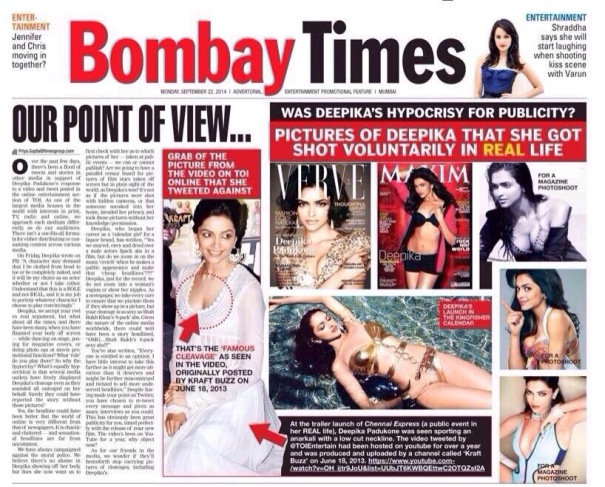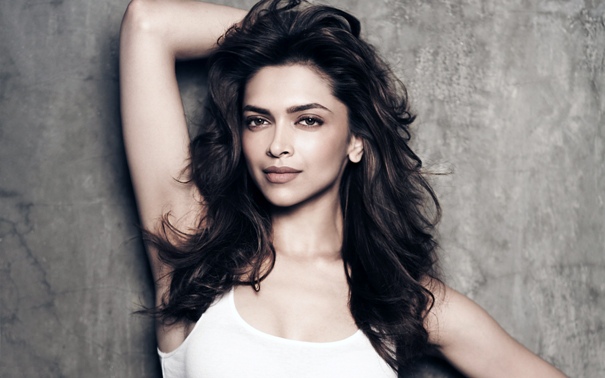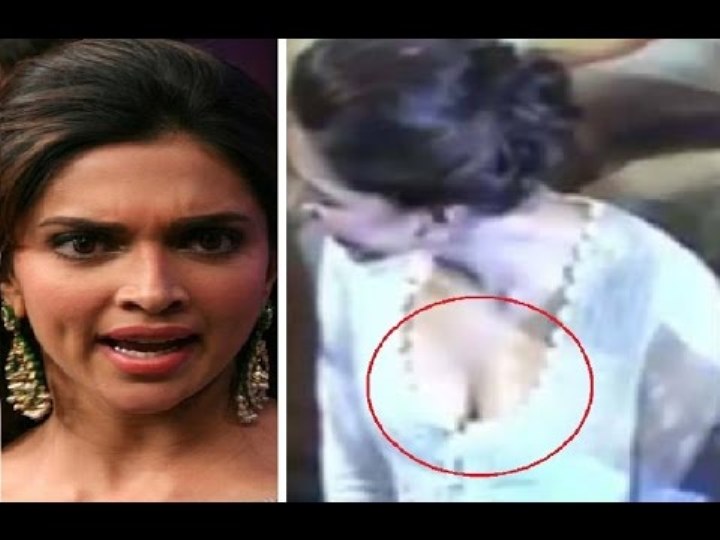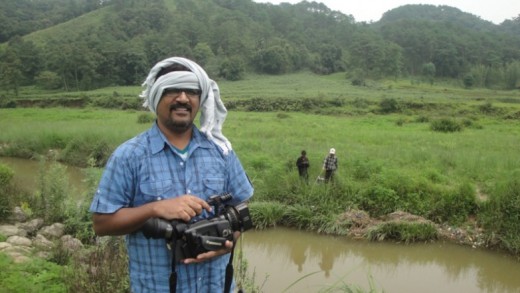Ms. Padukone is part of the problem she outrages about. All the support for her is misplaced and undeserving.
In the spat between the Times of India – India’s most widely read English newspaper – and Deepika Padukone, the newspaper came out with an official response in which it splashed images of her cleavage from earlier photoshoots.
Here is what the controversy is about. The publication stooped low – using a photo from an intrusive angle for an article while highlighting the cleavage – and gave it a cheap headline. It did so without the explicit consent of the actress.
As for the newspaper, it often stoops to attract the lowest hanging fruits in its readership (for example, gems like “Richa Chadda caught adjusting her innerwear” and a slideshow of celebs married to dark partners). Its reputation was always suspect to begin with.
As has become a tradition lately, Padukone tweeted about the “disrespect” done to all women. She followed it up with many re-tweets and a Facebook note that got over 14,000 shares. Soon enough, her “bold stand” was supported by hashtags like #IStandWithDeepikaPadukone and #Respect.
For someone who endorses a “fairness cream”, this incident brings her dangerously close to being hailed as Bollywood’s poster girl for women’s rights. The bigger question is — where was the disrespect for ALL women that she enlisted in her campaign?
Well, there isn’t any – at least not the kind she alleges. Although the publication stops short of an apology in its response, it does admit that the headline wasn’t a great one. It also clarifies that “there’s no shame in Deepika showing off her body.” After all, it is one of the many publications that survive on showing semi-naked bodies of young, good-looking people.

There were barely any who had anything good to say about the Times of India’s point of view.
When actress Katrina Kaif’s holiday photos in Spain were leaked, Ms. Padukone had said, “… I believe if you are a celebrity or public figure… these things are bound to happen. And I don’t think you can accuse anybody of anything. If I am a public figure and if someone has captured me then I feel I should have been a little careful.”
To be clear, regardless of her past statements and appearances on magazine covers, Ms. Padukone has the same rights as a nun or a bar dancer. No publication has the liberty to use the photos the way the Times of India did.
If only her outrage had been limited to this issue of consent for using the photograph. Instead, she threw in terms for just about every problem facing women today. Her Facebook note started with “There is only ONE sign that a woman wants to have sex and that is that she says ‘YES’ .”
Unfortunately, there is no such applicable rule for a photo or video. After all, the Times of India presumed (and still does) that it had the consent of the actress. Many photos in tabloids – if not most – are clicked with implied or assumed consent. Most tabloids will run out of business is they had to rely only on photoshoots or “approved images.” Since photos are not rubber-stamped for approval or sent along with “terms for use,” celebrities will have to trust the discretion of editors.
Even if we knew what exactly consent is, how many take it seriously? In the anonymity and enormity of the internet, consent counts for nothing. Out in the real world, there will always be a publication or tabloid or news outlet willing to sidestep or bend the idea of consent using a loophole. How else would we have all gotten to see Ms. Kaif holidaying in Spain? Quite often, the lure of using such a photo exceeds the expectation of privacy and consent.

Jennifer Lawrence was among the many whose naked photos were leaked online by a nameless, faceless hacker.
Finally, even if the Times of India had obtained consent from the actress for the photo and used a better worded but equally objectifying headline, would everything have been hunky-dory? No, it would still have been objectifying. When seen through the lens of objectification alone, there is not much difference between the photo the Times of India had used and the magazine covers for which Ms. Padukone posed.
By using the term “objectification,” Ms. Padukone only invited questions about her work and endorsements. Be it her bikini-clad pose for a calendar or acres of skin for magazine covers, for whom were these titillating photos meant? Is it the case that her 5’9, near flawless body has nothing to do with these photos? What about the Nescafe commercial where she wiggles her hips to a sexually suggestive song? Weren’t these “regressive tactics?”
Of course, the actress is well within her right to portray these characters. It is also beyond this piece to study the extent of objectification and its consequences. There are those who think it allows women a freedom to choose their attire and behaviour. As true as it is, Bollywood needs to answer why women (and largely only women) are being sexed up so often? And for whom?
Yet it can be stated that Ms. Padukone has spent a good part of her career catering to the very male gaze she has now denounced. She is as much a part of the problem as the paparazzi who chase her and the reader who flips through such images with his morning coffee. Whether or not she has had a change of heart, the least she can do is acknowledge it.
As for her defence of the roles she has done, it is a familiar and flimsy excuse given by other actresses before her for having done sexed-up, clichéd characters. If she means what she says in her Facebook note, then it is time for her to take roles that show women as something more than a sex object or arm-candy as Vidya Balan has been doing and Kangana Ranaut has done recently.
It will also be a step against the excessive sexualization of women in contemporary Indian movies. And lest I be accused of singling out Ms. Padukone, I hope the Kapoors, Khans and Kaif also take a lead in this direction. Ditto for the rest of Bollywood which rallied behind the actress!

You don’t always need sex to make a movie or a point. Stills from left to right: English Vinglish, Queen, Kahaani
This article was never meant for Ms. Padukone though. She is free to believe what she wants and use social media accordingly.
It is meant for all those who tweeted, shared her Facebook note, and even started petitions against the newspaper. Since the actor can hire bodyguards and PR advisors, does she even need your support? Shouldn’t you think about the two girls who were killed and hung from a tree in Badaun as her killers are still at large? Or spare a tweet for the two bright girls in Rohtak who committed suicide after being stalked by a few men? Or if you want to talk about happy things, why not write a congratulatory note for our engineers at the Indian Space Research Organization (ISRO)?
The support for the actor shows a significant change in the collective mood. If only it were tapped in ways that yielded something and by people who genuinely deserve it. I would have wholeheartedly agreed with the Facebook note if it had been written by someone else – someone who does what she says. Sadly, beyond adding an army of followers for Ms. Padukone and throwing a truckload of condemnation for the Times of India, the debate hasn’t gone an inch deeper.

 Sreenivasan Iyer
Sreenivasan Iyer











